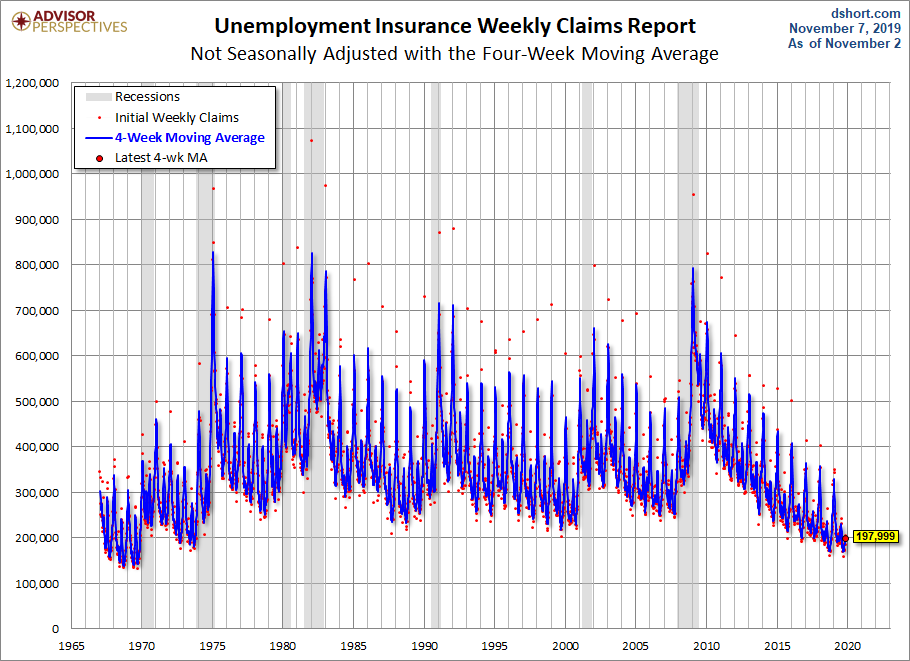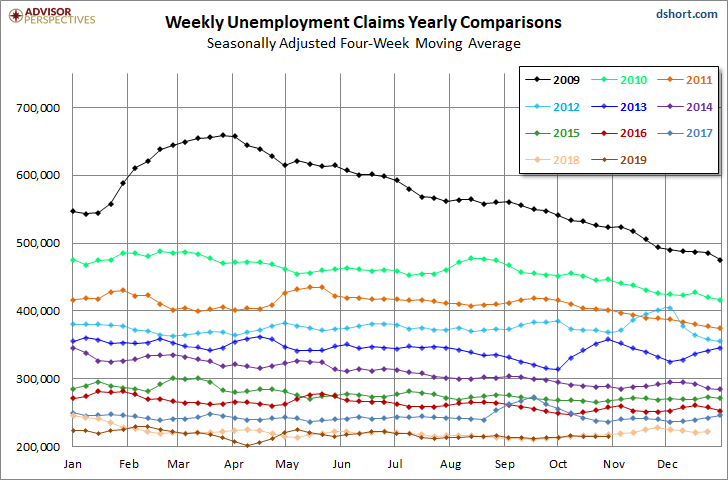Summary
Thursday morning's seasonally adjusted 211K new claims, down 8K from the previous week's revised 219K, was worse than the Investing.com forecast of 215K.
Below is a close look at the data over the decade (with a callout for the past year), which gives a clearer sense of the overall trend in relation to the last recession.
For an analysis of unemployment claims as a percent of the labor force, see regularly updated piece The Civilian Labor Force, Unemployment Claims and the Business Cycle.
 By Jill Mislinski
By Jill Mislinski
Here is the opening statement from the Department of Labor:
In the week ending November 2, the advance figure for seasonally adjusted initial claims was 211,000, a decrease of 8,000 from the previous week's revised level. The previous week's level was revised up by 1,000 from 218,000 to 219,000. The 4-week moving average was 215,250, an increase of 250 from the previous week's revised average. The previous week's average was revised up by 250 from 214,750 to 215,000. [See full report]
Thursday morning's seasonally adjusted 211K new claims, down 8K from the previous week's revised 219K, was worse than the Investing.com forecast of 215K.
Here is a close look at the data over the decade (with a callout for the past year), which gives a clearer sense of the overall trend in relation to the last recession.

As we can see, there's a good bit of volatility in this indicator, which is why the 4-week moving average (the highlighted number) is a more useful number than the weekly data. Here is the complete data series.

The headline Unemployment Insurance data is seasonally adjusted. What does the non-seasonally adjusted data look like? See the chart below, which clearly shows the extreme volatility of the non-adjusted data (the red dots). The 4-week MA gives an indication of the recurring pattern of seasonal change (note, for example, those regular January spikes).
![250652db19b8cb57476618f502708dd4.png]()
Because of the extreme volatility of the non-adjusted weekly data, we can add a 52-week moving average to give a better sense of the secular trends. The chart below also has a linear regression through the data. We can see that this metric continues to fall below the long-term trend stretching back to 1968.
![Nonseasonally Adjusted 52-week MA]()
Annual Comparisons
Here is a calendar-year overlay since 2009 using the 4-week moving average. The purpose is to compare the annual slopes since the peak in the spring of 2009, near the end of the Great Recession.
![Yearly Overlay]()
For an analysis of unemployment claims as a percent of the labor force, see regularly updated piece The Civilian Labor Force, Unemployment Claims and the Business Cycle. Here is a snapshot from that analysis.
![Initial Claims to the CLF]()
Original post
Editor's Note: The summary bullets for this article were chosen by Seeking Alpha editors.
Summary
Thursday morning's seasonally adjusted 211K new claims, down 8K from the previous week's revised 219K, was worse than the Investing.com forecast of 215K.
周四上午,经季节调整的新申领失业救济金人数为21.1万人,比前一周修正后的21.9万人减少了8K人,逊于Investing.com预测的21.5万人。
Below is a close look at the data over the decade (with a callout for the past year), which gives a clearer sense of the overall trend in relation to the last recession.
下面是过去十年的数据(带有过去一年的标注),让我们更清楚地了解了与上一次衰退相关的整体趋势。
For an analysis of unemployment claims as a percent of the labor force, see regularly updated piece The Civilian Labor Force, Unemployment Claims and the Business Cycle.
有关申领失业救济金人数占劳动力的百分比的分析,请参阅定期更新的文章平民劳动力、失业申领人数和商业周期。
吉尔·米斯林斯基(Jill Mislinski)著
Here is the opening statement from the Department of Labor:
In the week ending November 2, the advance figure for seasonally adjusted initial claims was 211,000, a decrease of 8,000 from the previous week's revised level. The previous week's level was revised up by 1,000 from 218,000 to 219,000. The 4-week moving average was 215,250, an increase of 250 from the previous week's revised average. The previous week's average was revised up by 250 from 214,750 to 215,000. [See full report]
11月2日止当周,经季节调整的初请失业金人数预估为21.1万人,较前一周修正后的水平减少8000人。前一周的水平被上修了1,000点,从21.8万点上修至21.9万点。四周移动均值为215,250,较前一周修正后均值增加250。前一周均值被上修250点,从214,750点上修至215,000点。[查看完整报告]
Thursday morning's seasonally adjusted 211K new claims, down 8K from the previous week's revised 219K, was worse than the Investing.com forecast of 215K.
周四上午,经季节调整的新申领失业救济金人数为21.1万人,比前一周修正后的21.9万人减少了8K人,逊于Investing.com预测的21.5万人。
Here is a close look at the data over the decade (with a callout for the past year), which gives a clearer sense of the overall trend in relation to the last recession.
以下是过去十年的数据(带有过去一年的标注),让我们更清楚地了解了与上一次衰退相关的整体趋势。

As we can see, there's a good bit of volatility in this indicator, which is why the 4-week moving average (the highlighted number) is a more useful number than the weekly data. Here is the complete data series.
正如我们所看到的,这个指标有很好的波动性,这就是为什么四周移动平均线(突出显示的数字)比每周数据更有用的数字。以下是完整的数据系列。

The headline Unemployment Insurance data is seasonally adjusted. What does the non-seasonally adjusted data look like? See the chart below, which clearly shows the extreme volatility of the non-adjusted data (the red dots). The 4-week MA gives an indication of the recurring pattern of seasonal change (note, for example, those regular January spikes).
整体失业保险数据经季节性调整。未经季节调整的数据是什么样子?见下图,它清楚地显示了未调整数据(红点)的极端波动性。四周均线给出了季节性变化的周期性模式的指示(注意,例如,那些定期的1月份峰值)。

Because of the extreme volatility of the non-adjusted weekly data, we can add a 52-week moving average to give a better sense of the secular trends. The chart below also has a linear regression through the data. We can see that this metric continues to fall below the long-term trend stretching back to 1968.
由于未经调整的周度数据的极端波动性,我们可以加上52周移动平均线,以便更好地了解长期趋势。下面的图表还对数据进行了线性回归。我们可以看到,这一指标继续低于追溯到1968年的长期趋势。

Annual Comparisons
Here is a calendar-year overlay since 2009 using the 4-week moving average. The purpose is to compare the annual slopes since the peak in the spring of 2009, near the end of the Great Recession.
以下是自2009年以来使用4周移动平均线的历年覆盖情况。这样做的目的是比较自2009年春季,也就是大衰退接近尾声时达到顶峰以来的年度坡度。

For an analysis of unemployment claims as a percent of the labor force, see regularly updated piece The Civilian Labor Force, Unemployment Claims and the Business Cycle. Here is a snapshot from that analysis.
有关申领失业救济金人数占劳动力的百分比的分析,请定期参阅更新后的片断平民劳动力、申领失业救济金人数和经济周期。以下是该分析的快照。

Editor's Note: The summary bullets for this article were chosen by Seeking Alpha editors.
编者注:本文的摘要项目符号是由寻找Alpha编辑选择的。

 By Jill Mislinski
By Jill Mislinski




